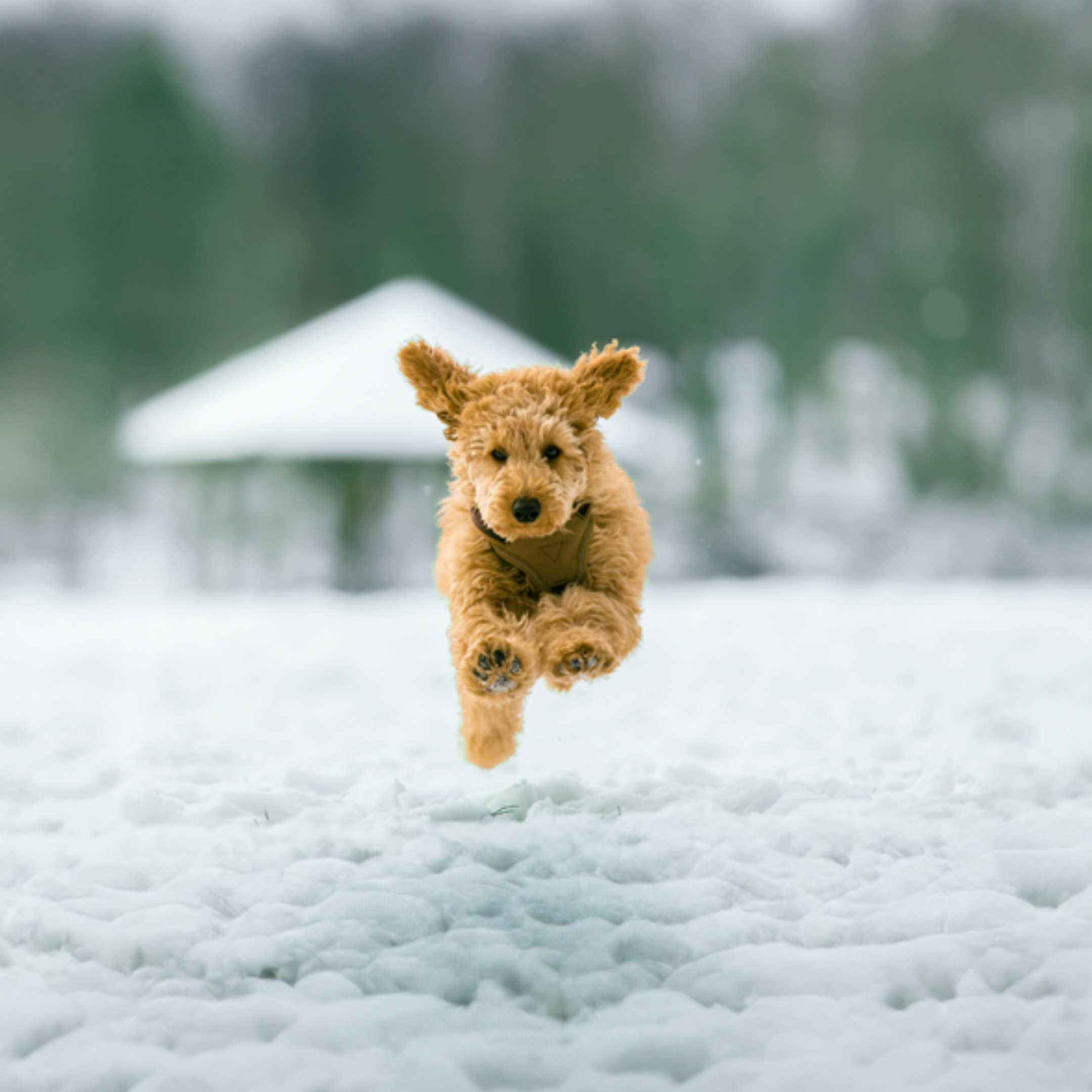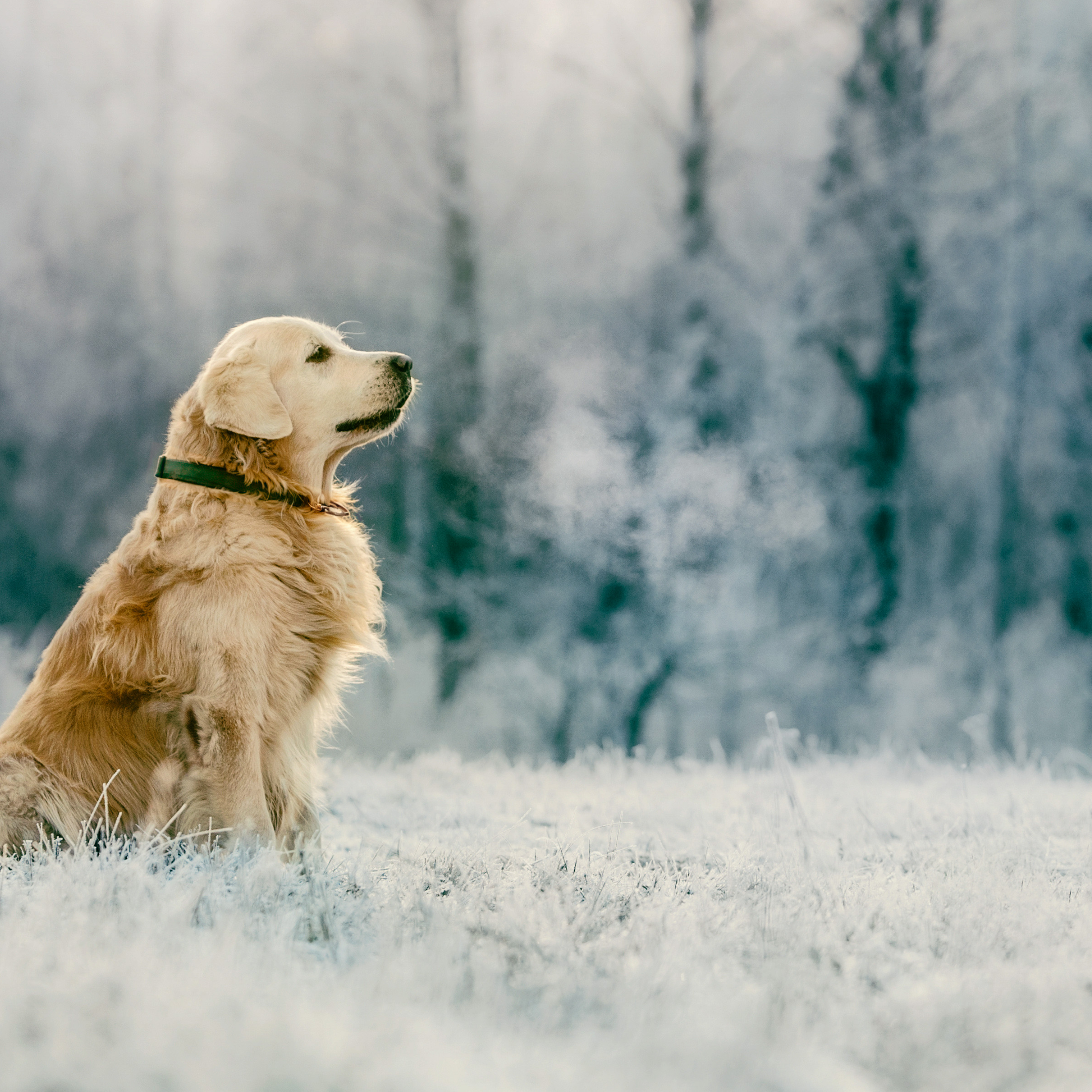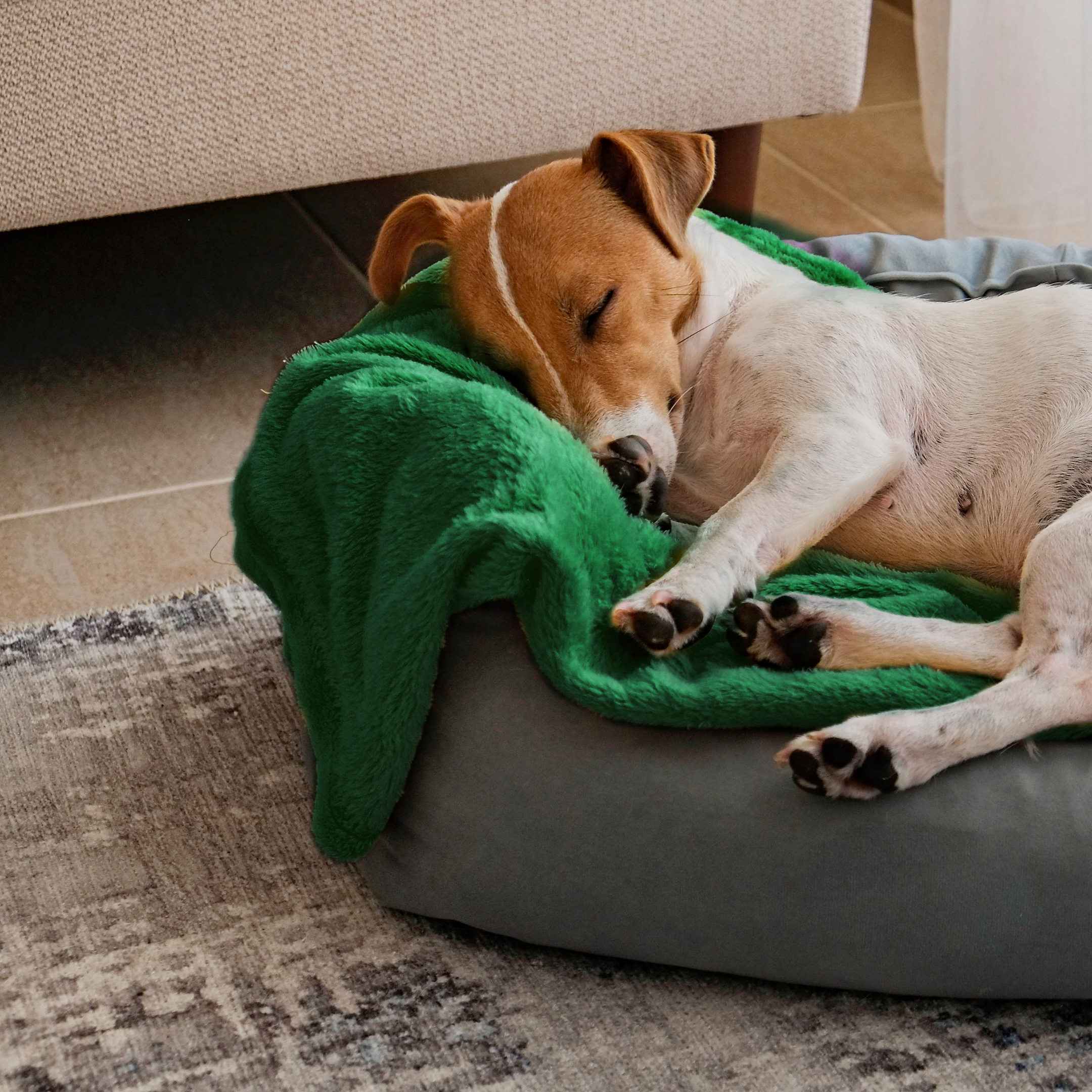HOW TO HELP YOUR DOG STAY WARM, ALL WINTER LONG
Table of Contents
When is it too cold to walk your dog?
How do I know if my dog’s cold?
How can I protect my dog from the cold?
What activities can I do with my dog when it’s cold?
Do I need to feed my dog more in the winter?
What’s the best way to deal with cold, muddy paws?
How do I choose the best coat for my dog?
Your cold weather FAQs
- Do dogs feel the cold?
- When is it too cold to walk your dog?
- Can you walk your dog in the snow?
- Do dogs get colds or the flu?
To sum it all up…
The weather’s getting colder, the days are getting shorter. Winter’s on its way. If you’re a pet parent, how can you keep your four-legged family member cosy when it’s chilly outside? In this blog, we’ll be sharing our tips for walking dogs in cold weather, and we’ll get to grips with lots of cold-related questions. Do dogs feel the cold? When is it too cold to walk your dog? Should you walk your dog in the snow? And what temperature is too cold for dogs? Let’s find out.
When is it too cold to walk your dog?
Do dogs feel the cold? Yes, of course. But every dog’s different, and just like people, some feel it more than others. So if you’re wondering what temperature is too cold for dogs, there isn’t one single answer. Some breeds love going out in the ice and snow, while others prefer to stay at home.
So what can you do to keep your dog happy? First, we recommend you take into account their breed, shape and size. Dog breeds that originated in colder places, like Huskies, Newfoundlands and German Shepherds, generally cope well with the cold because they’re naturally better insulated. These cold weather dogs tend to love winter weather. On the other hand, dogs with thinner coats like Greyhounds or shorter legs like Dachshunds, will get colder sooner. They will probably appreciate a jumper or jacket on winter walks, and it’s good to consult a dog walking temperature chart on extra-chilly days.
If you’re wondering if you should walk your dog in the snow, consider actual weather conditions and whether it’s actually practical to go out. While freshly fallen snow might be delightful, frozen local footpaths are a different story. Ice, salt and grit can be harsh on their paws. Can dogs walk on ice? Slightly better than humans thanks to their low centre of gravity, but there’s always a possibility they might slip on the ice, hurt themselves and pull you down with them.
 How do I know if my dog’s cold?
How do I know if my dog’s cold?
Thanks to their fur coats, cold temperatures for dogs might be lower than what’s cold for humans. That being said, just like humans do, dogs get cold in winter. They just can’t tell you! Thankfully, you can watch out for the telltale signs.
Just like us, dogs often shiver when they’re cold. You may have noticed this after your dog has been swimming. After walking dogs in cold weather, you should ensure they are warm and dry. You might also notice them curling up more tightly than usual, creating a doughnut shape to keep warm. If your dog’s feeling the cold, they might also stick to warmer areas of the house, or lie next to radiators or fires. That’s fine, provided they aren’t too close and don’t stay there too long, because they can easily singe their fur or nose or exacerbate skin conditions in dogs. Some dogs are also cuddlier when they’re cold, so if your dog is asking for extra hugs, they might be chilly and hoping to share some of your warmth.
Finally, keep an eye on your dog’s energy levels, as these might change. In response to cold weather, dogs might become more sluggish, while others race around to warm themselves up. The important thing is to keep an eye on them on colder days, so you know how they react, and can recognise when they need help to warm up.
How can I protect my dog from the cold?
On cold days at home, most dogs will appreciate extra blankets in their beds. You can add heat pads for more warmth and if your dog tends to get extra chilly, you can even buy heated dog beds to really ramp up the cosiness! If you’re using a hot water bottle, make sure it’s not filled with boiling water so your dog won’t scald themselves if there’s a spillage. Make sure any hot water bottles or heat pads aren’t chewable either.
If you’re heading out for a walk, there are all sorts of dog jumpers and coats available to keep your furry friend cosy.We’ll share some tips on choosing the right one below.
When is it too cold to walk your dog?
Asking when is it too cold to walk your dog is less about the temperature and more about the conditions and your dog’s own preferences. Dog walking temperature charts, widely available online, are a great reference if you’re in doubt – but it does vary from breed to breed.
As we mentioned, frozen footpaths can be slippy for you and your dog, and ice can be tough on their paws. A great alternative is to head for somewhere grassy, where cold conditions won’t stop your dog being able to grip the ground and run. Just watch out for frozen ponds and streams, especially if you’re somewhere unfamiliar, as dogs can easily slip or fall through the ice. Wherever you go, when it’s time to head home, check their paws for clumps of snow or ice, which can be harmful if they hang around too long.
Remember, if your dog doesn’t want to go outside in the cold, don’t force them. There are plenty of things they can do at home. Here are some great tips.
What activities can I do with my dog when it’s cold?
For breeds who don’t mind the cold, walking dogs in cold weather is a huge treat. It’s a great excuse to venture off your usual route in search of a frosty field or park. Cold weather dogs delight in snow: digging in it and chasing snowballs! This is a fun bonding activity for both of you. Just make sure they don’t eat too much snow, or anything that might be hidden inside it. And bear in mind that when they need to go to the toilet, it might take a little longer than usual in cold temperatures. For dogs, warming up is necessary for them to relax enough to go.
For other breeds, dogs and cold weather don’t mix. If your dog doesn’t want to go out, don’t force it! There are plenty of enriching activities to help them stay active and stimulated at home. Most dogs love hide and seek, whether they’re looking for you or their favourite toys and treats. It’s also a good time to use interactive feeders like Kongs, cubes, spheres or slow bowls that make mealtimes and snacks more interesting.
If you’ve got time, you might want to come up with fun tricks to teach your dog. We love twisting snacks inside a tea towel for them to untangle – just make sure they don’t chew the towel too! Another easy-to-set-up game is putting treats inside an egg box, then hiding the box in the house. Our Natures Menu Meaty Treats are perfect for this. They’ll enjoy sniffing out the snacks and tearing up the box while they’re at it. If you’ve got a bigger box to hand, you could try making them a lucky dip by hiding snacks in some shredded paper. It’s definitely messy, but they’ll love it!
 Do I need to feed my dog more in the winter?
Do I need to feed my dog more in the winter?
It completely depends on your dog. If your dog loves the winter and running around in the cold, they might actually be running around even more than usual to stay warm. If you think that’s the case, and they’re gulping down their food, they might need a little extra.
On the other hand, if your furry friend tends to slow down, get sluggish and go out less in the winter, they won’t be using as much energy and you might want to reduce their portion sizes so they don’t gain weight.
Whether you’re sizing up or down, it’s important to make sure their meals contain all the nutrients they need. If you’re giving your dog a raw diet, our Complete & Balanced nuggets make that really easy.
What’s the best way to deal with cold, muddy paws?
Winter walks can get pretty mucky, so make sure your dog gets clean, warm and dry afterwards. If you’re heading out in the car, take some old towels to rub down cold, soggy dogs and make the journey home more comfortable. Make sure the bedding you’ve got in the car is designed to draw water away from their bodies, so they don’t start to feel the cold while you’re travelling.
Once you get your dog home, give them a proper wash. Mud can harbour all sorts of bacteria and clumps of snow or ice can linger and be damaging, so rinse them away in warm water. For some added pampering (and cleaning power!) use a pet-friendly shampoo or soap bar too.
Even if your dog’s not especially muddy, if they’ve been walking somewhere icy or the paths have been gritted with salt, that can be damaging to the pads on their paws. Clean them up with warm water and a flannel – if they enjoy giving you their paw, chances are they’ll find this a treat.
Once all the washing’s done, make sure you dry your dog really well. If they seem chilly, dress them in a dog jumper or coat until they’ve warmed up again.
How do I choose the best coat for my dog?
Ask them to help! There are lots of dog coats and jackets out there. That doesn’t mean your dog will fit into or feel comfortable in all of them. Trying to get a dog into a coat they don’t like is an uphill battle, so take them to the shop and try a few on. If they’re immediately trying to wriggle out, that’s probably a sign they’re not comfortable, so keep looking until you find something they’ll calmly accept to wear.
Whatever you and your dog choose, make sure they can move freely, and that any straps don’t make walking awkward. The coat should be long enough to reach their bottom, not just their front quarter, and reflective panels can be a great idea for walking on dark winter mornings and evenings. As long as you’ve ticked all of those boxes, have fun – your dog won’t be picky about the pattern!
 Your cold weather FAQs
Your cold weather FAQs
Do dogs feel the cold?
Yes, absolutely, but some feel it more than others. Generally cold weather dogs are from breeds that originated in cold climates. They will naturally be better insulated, while other dogs and cold weather don’t get on. These are generally breeds with less fur or short legs, who get colder faster.
When is it too cold to walk your dog?
Unlike summer heat, there’s no saying what temperature is too cold for dogs. It’s all down to their breed and preference. If your dog wants to go out, just keep an eye on slippery ice and their body language to make sure they’re not getting too chilly. And if they don’t want to go out, don’t force them.
Can dogs go out in the snow?
Yes! Although some dogs don’t like the snow, lots love running through it and chasing snowballs. Just make sure you remove any clumps of ice or snow, and ensure your dog is dry and warm once you’re done.
Do dogs get colds or the flu?
No, they don’t. But do dogs feel the cold? Of course. If your dog gets too chilly for too long, it can make them unwell, so watch out for signs they’re cold, help them get warm and if you’re worried, call your vet.
To sum it all up…
Just like us, some dogs love a winter walk and others prefer to stay home on the sofa. If your dog’s the indoor type, don’t push them to go out, just make sure they stay active, stimulated and cosy at home. On the other hand, if they’re eager to go out on an adventure, steer clear of icy paths and frozen water, head for grassy areas and make sure you get them clean, warm and dry once the adventure’s over.








 How do I know if my dog’s cold?
How do I know if my dog’s cold? Do I need to feed my dog more in the winter?
Do I need to feed my dog more in the winter? Your cold weather FAQs
Your cold weather FAQs